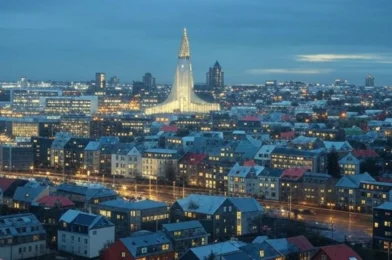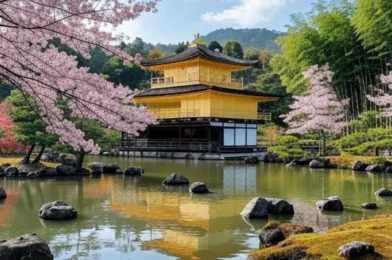Why Reykjavik Is a Nordic Dream
Reykjavik, Iceland’s vibrant capital, is a city where rugged nature meets quirky charm. Sitting on the edge of the Atlantic, it’s the northernmost capital in the world, blending colorful houses, geothermal pools, and a thriving arts scene. Small but mighty, Reykjavik serves as the gateway to Iceland’s wild landscapes think geysers, waterfalls, and the Northern Lights while offering a cozy urban escape with a big personality.
This isn’t your typical city break. Reykjavik pairs the thrill of adventure with the warmth of Icelandic hospitality, all wrapped in a compact, walkable package. Whether you’re chasing auroras, soaking in a hot spring, or sipping coffee in a hip café, Reykjavik delivers a trip that’s equal parts exhilarating and serene. Let’s explore what makes it special and how to plan your Icelandic adventure.
Top Attractions in Reykjavik
Reykjavik’s highlights are a mix of cultural icons and natural wonders, all within easy reach.
Hallgrímskirkja: A Towering Landmark
Hallgrímskirkja, a striking modernist church, dominates Reykjavik’s skyline with its basalt-column-inspired design. Climb the tower for panoramic views of the city, harbor, and distant mountains. Inside, the minimalist decor and massive organ create a peaceful vibe. It’s a cultural touchstone that’s as photogenic as it is inspiring.
Harpa Concert Hall: Art Meets Architecture
On the waterfront, Harpa Concert Hall dazzles with its honeycomb-like glass façade, reflecting the sky and sea. Home to concerts and exhibitions, it’s a hub of creativity. Even if you don’t catch a show, the building’s geometric beauty and nearby Old Harbour views make it worth a visit.
Sun Voyager: A Seaside Sculpture
The Sun Voyager, a sleek steel sculpture resembling a Viking ship, sits along the shore, symbolizing hope and exploration. It’s a serene spot to watch the waves or catch a sunset, with Mount Esja as a dramatic backdrop. Pair it with a stroll along the Sculpture and Shore Walk for a dose of art and nature.
Nature’s Playground Around Reykjavik
Reykjavik is the perfect base for Iceland’s natural wonders, with day trips that showcase the country’s raw beauty.
The Golden Circle: A Classic Adventure
Just outside the city, the Golden Circle route packs a punch: Thingvellir National Park, where tectonic plates meet; Geysir, with its erupting hot springs; and Gullfoss, a thundering waterfall. Rent a car or join a tour it’s a half-day journey that captures Iceland’s geological magic.
Blue Lagoon: Geothermal Bliss
Though closer to the airport, the Blue Lagoon is a must-do from Reykjavik. Its milky-blue, mineral-rich waters, surrounded by lava fields, offer a surreal soak. Book ahead, slather on a silica mask, and let the 38°C warmth melt away your cares. It’s relaxation with a wow factor.
Reykjavik’s Cultural and Culinary Scene
Reykjavik’s small size belies its big heart, with a food and arts scene that punches above its weight.
Icelandic Eats to Savor
Try harðfiskur, dried fish served with butter, or plokkfiskur, a comforting fish stew with potatoes. For the brave, hákarl (fermented shark) is a pungent local delicacy chase it with brennivín, a caraway-flavored spirit. Lamb dishes, like slow-roasted kjötsúpa, highlight Iceland’s farm-to-table ethos. End with skyr, a creamy yogurt-like dessert often topped with berries.
Café Culture and Nightlife
Reykjavik’s cafés, like Sandholt Bakery, serve up artisan bread and strong coffee perfect for chilly days. By night, Laugavegur Street buzzes with bars and live music venues. From folk tunes to electronica, the city’s nightlife is eclectic and welcoming, with no need for fancy dress just warm layers.
Practical Tips for Visiting Reykjavik
A little prep ensures your Reykjavik trip shines. Here’s the rundown.
Best Time to Go
Summer (June to August) offers long days and mild weather, ideal for exploring. Winter (November to March) brings shorter days but prime Northern Lights viewing pack thermal gear. Spring and fall are quieter, with a mix of both worlds. Weather shifts fast year-round, so layers are key.
Getting Around
Reykjavik is walkable, with most sights in the city center. Buses connect outer areas, and bike rentals work in summer. For day trips, rent a car or book a tour roads are well-maintained, but watch for winter ice. Taxis are pricey but handy late at night.
Where to Stay
Stay downtown near Laugavegur for easy access to shops and nightlife. Waterfront hotels offer harbor views, while guesthouses in quieter areas like Vesturbær suit budget travelers. For a treat, book a spot with a hot tub geothermal perks are everywhere.
Hidden Gems in and Around Reykjavik
Beyond the main draws, Reykjavik has lesser-known spots that reward the curious.
Perlan: Views and More
Perlan, a glass-domed building atop Öskjuhlíð hill, boasts an observation deck with 360-degree views. Its Wonders of Iceland exhibit dives into glaciers and volcanoes, complete with an ice cave. It’s a quick trip from downtown with a big payoff.
Reykjadalur: A Hot Spring Hike
A short drive south, Reykjadalur offers a hike to a warm river where you can bathe amid steaming valleys. It’s a 45-minute trek from the trailhead, so bring a swimsuit and sturdy shoes. The reward? A natural hot tub in the wild.
Why Reykjavik Steals Your Heart
Reykjavik is a city of quiet wonders where the sky dances with lights, the earth bubbles with heat, and the people greet you with a smile. It’s a place that feels both remote and intimate, blending the raw power of nature with the warmth of a small town. Whether you’re gazing from a church tower, soaking in a lagoon, or tasting fermented shark, Reykjavik leaves an imprint that’s uniquely its own.
Ready to chase the Northern Lights or dive into Iceland’s cool capital? Reykjavik is calling start planning your Nordic escape today.




